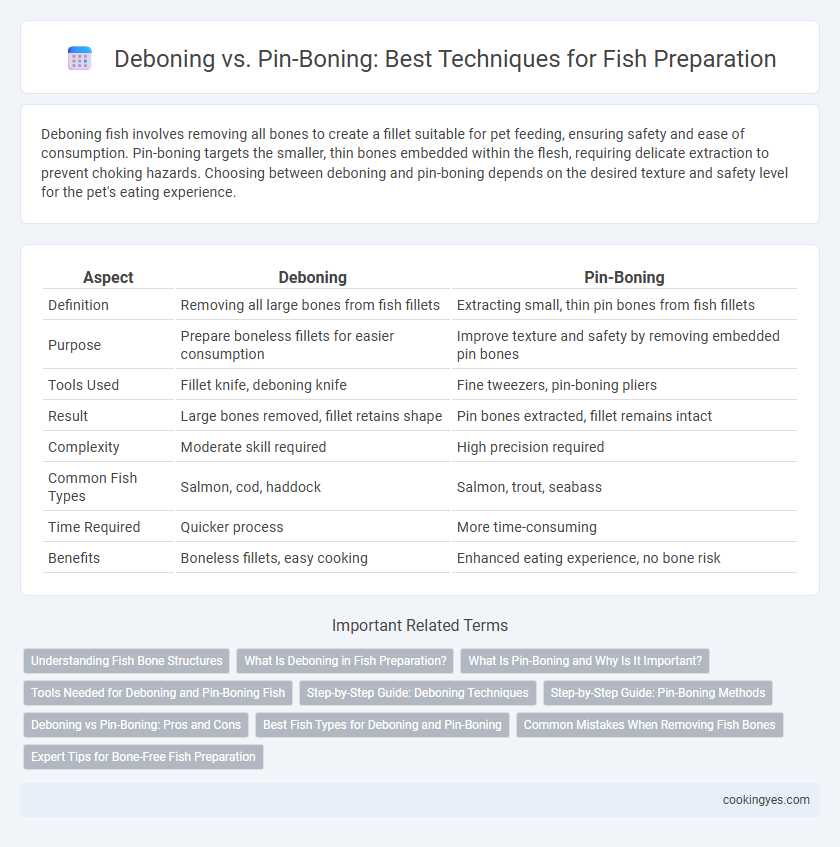Deboning fish involves removing all bones to create a fillet suitable for pet feeding, ensuring safety and ease of consumption. Pin-boning targets the smaller, thin bones embedded within the flesh, requiring delicate extraction to prevent choking hazards. Choosing between deboning and pin-boning depends on the desired texture and safety level for the pet's eating experience.
Table of Comparison
| Aspect | Deboning | Pin-Boning |
|---|---|---|
| Definition | Removing all large bones from fish fillets | Extracting small, thin pin bones from fish fillets |
| Purpose | Prepare boneless fillets for easier consumption | Improve texture and safety by removing embedded pin bones |
| Tools Used | Fillet knife, deboning knife | Fine tweezers, pin-boning pliers |
| Result | Large bones removed, fillet retains shape | Pin bones extracted, fillet remains intact |
| Complexity | Moderate skill required | High precision required |
| Common Fish Types | Salmon, cod, haddock | Salmon, trout, seabass |
| Time Required | Quicker process | More time-consuming |
| Benefits | Boneless fillets, easy cooking | Enhanced eating experience, no bone risk |
Understanding Fish Bone Structures
Fish bone structures vary significantly depending on species, with some having intricate rib cages and others featuring delicate pin bones embedded in the flesh. Deboning involves removing all larger bones to create filet cuts, while pin-boning targets only the small, thin bones often missed in standard processing. Understanding the precise location and type of bones is essential for efficient fish preparation, improving texture and safety in culinary applications.
What Is Deboning in Fish Preparation?
Deboning in fish preparation involves the removal of all bones from the fillet, ensuring a smooth, bone-free texture ideal for cooking and consumption. This process typically includes extracting the central backbone and any smaller rib bones to produce clean, ready-to-eat portions. Proper deboning enhances the eating experience by minimizing the risk of choking hazards and improving presentation.
What Is Pin-Boning and Why Is It Important?
Pin-boning is the precise removal of small, thin bones that run along the fish fillet, ensuring a safer and more enjoyable eating experience. This technique is crucial for preventing choking hazards and enhancing the texture of dishes, especially in delicate fish such as salmon and trout. Mastery of pin-boning improves the overall quality of seafood preparation, catering to both culinary professionals and home cooks.
Tools Needed for Deboning and Pin-Boning Fish
Deboning fish requires heavier tools such as a sharp fillet knife and fish bone pliers to remove larger bones embedded within the flesh efficiently. Pin-boning uses finer, precision tools like specialized pin boning tweezers or needle-nose pliers designed to extract small, thin pin bones without damaging delicate fillets. Proper selection of these tools ensures clean cuts, minimizing flesh waste and enhancing the final presentation of fish dishes.
Step-by-Step Guide: Deboning Techniques
Deboning fish involves carefully cutting along the backbone and ribs to remove larger bones in a single section, preserving the fillet's structure for cooking. Pin-boning targets smaller, finer bones using tweezers or needle-nose pliers, requiring meticulous removal to ensure a completely boneless fillet. Mastery of these techniques improves culinary presentation and enhances eating experience by eliminating potential choking hazards.
Step-by-Step Guide: Pin-Boning Methods
Pin-boning fish involves removing thin, flexible bones called pin bones, typically found along the fillet's centerline, using specialized tweezers or pliers. Start by running your fingers gently over the fillet to locate the pin bones, which are often embedded just beneath the surface. Hold the fillet firmly, grip each pin bone near the flesh with tweezers, and pull smoothly at a slight angle following the bone's natural curve to avoid tearing the meat.
Deboning vs Pin-Boning: Pros and Cons
Deboning removes large bones from fish fillets, offering quicker preparation and minimal meat loss, but it can leave small bones behind that affect eating quality. Pin-boning removes small, fine bones, enhancing safety and texture, though it is more time-consuming and labor-intensive. Choosing between deboning and pin-boning depends on the desired balance between processing efficiency and final product refinement.
Best Fish Types for Deboning and Pin-Boning
Salmon and cod are ideal for deboning due to their larger, sturdier bones that can be removed in one piece, ensuring minimal flesh damage and maintaining fillet integrity. Pin-boning suits fish like trout and sea bass, where smaller, finer bones require careful extraction with specialized tweezers to achieve a clean fillet without affecting texture. Understanding the bone structure of each species enhances preparation efficiency and elevates the quality of the final dish.
Common Mistakes When Removing Fish Bones
Common mistakes when removing fish bones include using improper tools that cause tearing of the delicate flesh, leading to uneven fillets and waste. Inadequate lighting and poor grip on the fish can result in missed bones that pose choking hazards or affect texture. Failure to identify the difference between deboning, which removes all bones including the backbone, and pin-boning, targeting only the finer pin bones, often leads to incomplete bone removal and compromised dish quality.
Expert Tips for Bone-Free Fish Preparation
Deboning fish involves removing large bones along the fish's backbone, providing a more uniform fillet, whereas pin-boning targets the smaller, stubborn pin bones embedded within the flesh. Expert tips recommend using tweezers or specialized fish pliers to meticulously extract pin bones after filleting for a completely bone-free experience. Applying light pressure and working in good lighting enhances precision, ensuring the fish remains intact and safe for consumption.
Deboning vs Pin-Boning for Fish Preparation Infographic

 cookingyes.com
cookingyes.com